

The image reflects the toxic nature of the metal and its ‘mirror shine’ when polished.
| Density | 7 |
| Melting Point | 1907°C |
| Boiling Point | 2671°C |
Chromium is used to harden steel, to manufacture stainless steel (named as it won’t rust) and to produce several alloys.
Chromium plating can be used to give a polished mirror finish to steel. Chromium-plated car and lorry parts, such as bumpers, were once very common. It is also possible to chromium plate plastics, which are often used in bathroom fittings.
About 90% of all leather is tanned using chrome. However, the waste effluent is toxic so alternatives are being investigated.
Chromium compounds are used as industrial catalysts and pigments (in bright green, yellow, red and orange colours). Rubies get their red colour from chromium, and glass treated with chromium has an emerald green colour.
Chromium was discovered by the French chemist Nicholas Louis Vauquelin at Paris in1798. He was intrigued by a bright red mineral that had been discovered in a Siberian gold mine in 1766 and was referred to as Siberian red lead. It is now known as crocoite and is a form of lead chromate. Vauquelin analysed it and confirmed that it was a lead mineral. Then he dissolved it in acid, precipitated the lead, filtered this off, and focused his attention on the remaining liquor from which he succeeded in isolating chromium. Intrigued by the range of colours that it could produce in solution, he named it chromium from the Greek word chroma meaning colour. He then discovered that the green colouration of emeralds was also due to chromium